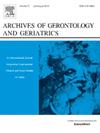Long fever Fever as a long-term risk factor for mortality in persons in assisted living facilities
IF 3.8
3区 医学
Q2 GERIATRICS & GERONTOLOGY
引用次数: 0
Abstract
Background
The aging population and increasing use of assisted living facilities necessitate a better understanding of risk factors for adverse outcomes. Fever as a long-term risk factor in elderly populations remains understudied.
Methods
We analyzed data from 16,523 veterans in assisted living facilities between 2012–2022, examining the relationship between fever (defined as temperature ≥100.4°F) and mortality at 90-, 365-, and 730-days post-admission. Subjects were categorized by fever timing (none, at intake, or after intake), temperature severity, and percentage of days febrile.
Results
Fever at intake and fever after admission were associated with significantly increased mortality compared to no fever (p < .001) at all time points. Higher fever temperatures (>105°F) and a greater percentage of days febrile (>5 %) correlated with worse mortality. Patients with fever at intake and a few percentage of days febrile (<5 %) had an OR of 1.24 (95 % CI 1.01–1.53) for mortality by 1 year compared to patients who did not have a fever. High (>105°F) early fever had an OR of 1.46 (95 % CI 1.20–1.78), and early fever with many days febrile (>5 %) had an OR of 1.53 (95 % CI 1.33–1.75) for mortality at 730 days compared to patients with no fever.
Conclusions
Fever in assisted living residents increases mortality risk for up to two years, depending on temperature severity and duration. These findings suggest a "long fever" phenomenon, where acute febrile episodes may have lasting consequences. Incorporating fever status into risk stratification may help identify high-risk patients requiring enhanced monitoring and care.

长期发热发热是辅助生活设施中人员死亡的长期危险因素
人口老龄化和辅助生活设施使用的增加需要更好地了解不良后果的风险因素。发热作为老年人的长期危险因素仍未得到充分研究。方法分析2012-2022年在辅助生活机构居住的16,523名退伍军人的数据,研究入院后90天、365天和730天发烧(定义为体温≥100.4°F)与死亡率的关系。受试者按发热时间(无发热、摄入时发热或摄入后发热)、体温严重程度和发热天数百分比进行分类。结果与不发热相比,入院时发热和入院后发热与死亡率显著增加相关(p <;.001)。较高的发热温度(105°F)和较高的发热天数百分比(5%)与较差的死亡率相关。与没有发烧的患者相比,入院时发热且发热天数占少数(5%)的患者1年死亡率的OR为1.24 (95% CI 1.01-1.53)。与无发热患者相比,高热(105°F)早期发热患者730天死亡率的OR为1.46 (95% CI 1.20-1.78),早期发热伴多天发热患者(> 5%)的OR为1.53 (95% CI 1.33-1.75)。结论根据温度严重程度和持续时间的不同,辅助生活居民的发烧可增加死亡风险,最长可达2年。这些发现表明存在一种“长期发热”现象,即急性发热发作可能产生持久的后果。将发热状况纳入风险分层可能有助于识别需要加强监测和护理的高危患者。
本文章由计算机程序翻译,如有差异,请以英文原文为准。
求助全文
约1分钟内获得全文
求助全文
来源期刊
CiteScore
7.30
自引率
5.00%
发文量
198
审稿时长
16 days
期刊介绍:
Archives of Gerontology and Geriatrics provides a medium for the publication of papers from the fields of experimental gerontology and clinical and social geriatrics. The principal aim of the journal is to facilitate the exchange of information between specialists in these three fields of gerontological research. Experimental papers dealing with the basic mechanisms of aging at molecular, cellular, tissue or organ levels will be published.
Clinical papers will be accepted if they provide sufficiently new information or are of fundamental importance for the knowledge of human aging. Purely descriptive clinical papers will be accepted only if the results permit further interpretation. Papers dealing with anti-aging pharmacological preparations in humans are welcome. Papers on the social aspects of geriatrics will be accepted if they are of general interest regarding the epidemiology of aging and the efficiency and working methods of the social organizations for the health care of the elderly.

 求助内容:
求助内容: 应助结果提醒方式:
应助结果提醒方式:


